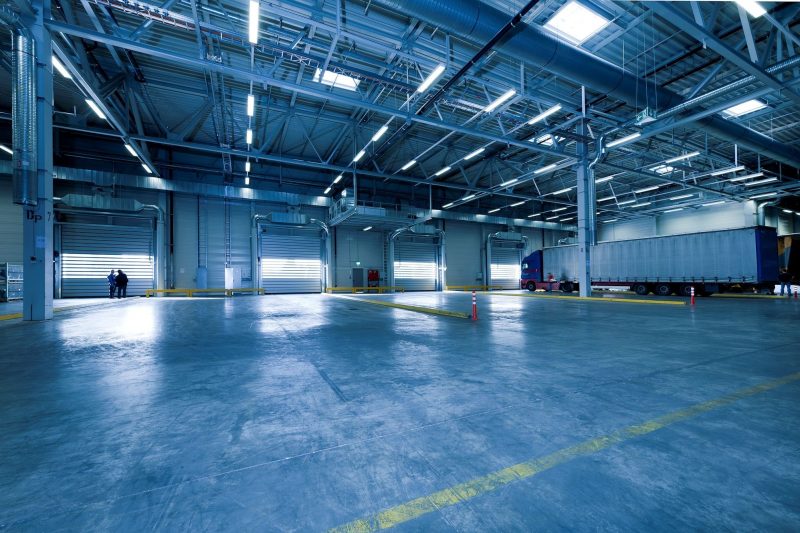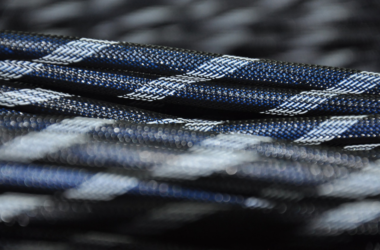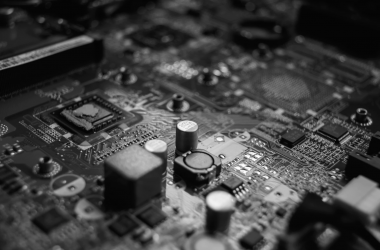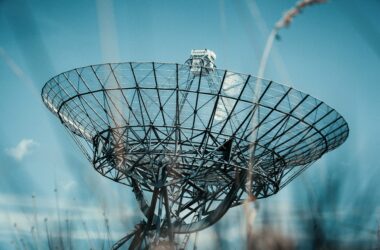In recent years, robots have successfully been deployed in companies and industries to help (or even replace) human labor. But there is still a large market gap in commercial floor cleaning. It’s typical in an institution such as airports or hospitals to find janitors multiple times a day breaking their backs to keep the floors clean. What if we could offload this repetitive and mundane work to a robot?
It turns out we could. There are several robot vacuum companies targeting industrial and commercial environments. While not as popular as household robot vacuums, these commercial robot vacuums are powerful and smart enough to avoid objects, obstacles, and people when cleaning. We spent hours researching, and these are the best industrial robotic vacuum cleaners for all of your commercial cleaning needs.
Investing in a good robotic vacuum cleaner for your warehouse or store frees up your workers to focus on other critical and high-value tasks. It is also an excellent way for managers to boost their workers’ productivity by eliminating the repetitive strain and fatigue resulting from cleaning and scrubbing floors every day.
Although they may not be as powerful as the classic industrial vacuums, they do have the advantage of autonomy, thus freeing up a pair of hands to do other tasks.
Talking to Forbes, Craig Rudin, head of janitorial supplies at GDI Integrated Facility Services, which bought six Neo cleaning robots, says adding the robots into the team has helped free up “workers to focus on cleaning bathrooms and garbage areas.” He also adds that the robots have helped the company “deal with both employee absenteeism, which runs 7% to 10% a day, and high turnover”.
Table of Contents
Best Industrial Robotic Vacuum Cleaners Compared
| Makita DRC200PT | Avidbots Neo 2 | SoftBank Robotics Whiz | TASKI AEROBOT 1850 | Uniring MAX | CYBERDYNE CL02 | |
|---|---|---|---|---|---|---|
| Image | 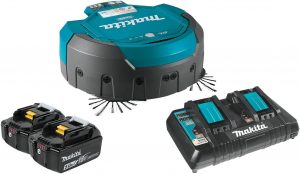 | 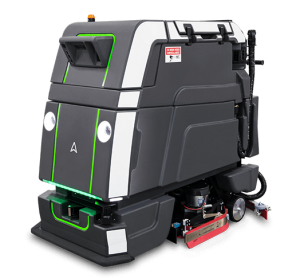 | 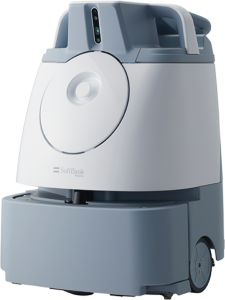 | 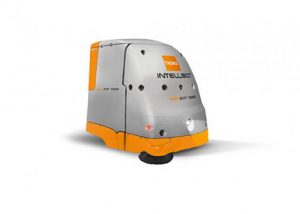 | 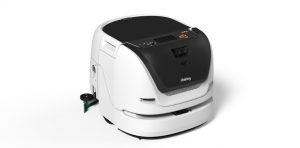 | 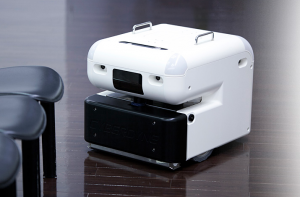 |
| Type | Vacuum | Scrubber | Vacuum | Vacuum | Vacuum + Scrubber | Vacuum |
| Navigation | IR Sensors | LIDAR + Camera Sensors | LIDAR + Camera Sensors | Ultrasonic + IR Sensors | LIDAR + Camera Sensors | Camera sensors |
| Object Avoidance | Bumper | Bumper | Bumper | Touch Shield | Bumper | Bumper |
| Brushes | 2x side brushes, 1x main brush | 26’’ Disc or 32’’ Disc | 1x main brush | 1x side brush, 1x main brush | 2x main brushes, 1x Concentric Circle Squeegee | 1x main brush |
| Capacity | 2.5L dustbin | 109L solution tank 135L recovery tank | 4L dustbin (bagged) | 38L dustbin | 2.5L solution tank, 2.5L recovery tank | N/A |
| Performance (Square meters) | 5,380 m2 (200 minutes) | 23,400 m2 (6 hours) | 1,500 m2 (3 hours) | 3,700 m2 (4 hours) | Up to 3,060 M2 (3.4 hours) | 3,000 m2 (2 hours) |
| Noise Level | 64 dB(A) | 72 dB(A) | 62 dB(A) | 65 dB(A) | N/A | N/A |
| Mapping | No | Yes | Yes | Yes | Yes | Yes |
| Keep Out Zones | Boundary Markers | Yes | Yes | Yes | N/A | N/A |
| Spot/Room Cleaning | No | Yes | Yes | Yes | Yes | Yes |
| Remote Management | No | Yes | Yes | Yes | Yes | Yes |
| Wi-Fi | No | Yes | Yes | Yes | Yes | Yes |
| Health & Safety | Audio and Lights alerts | Audio and Lights alerts | Audio and Lights alerts | Audio and Lights alerts | Audio and Lights alerts | Audio and Lights alerts |
| Dimensions (LWH) | 22 x 22 x 16 inches | 59.7 x 35.1 x 53.1 inches | 18.9 x 17.9 x 25.9 inches | 50 x 34.5 x 43 inches | 36.6 x 31.5 x 28.2 inches | 24.4 x 18.9 x 18.5 inches |
| Weight (lbs) | 17.2 | 1331.5 | 66 | 607 | 441 | 138.8 |
| Check Price | Check on Amazon | Check on Avidbots | Check on SoftBank Robotics | Check on TASKI | Check on Uniring | Check on Cyberdine |
Best Industrial Robotic Vacuum Cleaners – Our Picks
1. Makita DRC200PT – Best Industrial Robotic Vacuum Cleaner
Makita DRC200PT is the best industrial robot vacuum cleaner for most companies and commercial environments. It is intended for small businesses and large houses like warehouses and stores. Unlike other commercial robot vacuums that use a subscription model, the Makita DRC200PT is sold as a one-time purchase available in online stores.
The Makita DRC200PT brushless robotic vacuum is sold as a bare kit (robot vacuum only) or a full kit consisting of two 18V LXT 5.0Ah batteries and a dual-port charger. We highly recommend buying the latter since the robot vacuum does not come with a charging base. Having two batteries will give you more cleaning hours and less human intervention.
Design
Makita DRC200PT is a large robot vacuum. It is actually bigger than all the self-emptying robot vacuums we covered earlier but smaller than other commercial robot vacuums. The massive size is mainly to accommodate the large 2.5L dust box to provide sufficient capacity for commercial applications. You can easily remove the dustbin by lifting the top cover.
There is a high-efficiency filter just on top of the dust box, which traps dust, allergens, and pollutants, preventing them from being released into the air.The robot vacuum uses two side brushes and a main brush for suction. The side brushes come in handy when cleaning corners and along the edges and walls. On top of the robovac, there are different control buttons for power, cleaning mode, timer, buzzer, and a vacuum fan, to name a few. There are also indicators for battery, maintenance, and a cruise lamp.
The vacuum uses a buzzer and the cruise lamp, which you can turn off, to let people know when it’s around, great for health and safety. But I doubt you’re ever going to use that since it is loud when cleaning. It is not the noisiest robot cleaner, however, at 64 dB(A). You can set it to clean even during work hours.
Navigation
The Makita DRC200PT uses infrared sensors for smart navigation. It can clean in rows and efficient straight lines, allowing it to cover every corner without repeating cleaned areas. It has multiple other sensors onboard to easily navigate objects and obstacles, such as bumpers for object avoidance and cliff sensors to avoid steps and stairs.
Apart from smart navigation (Pattern Navigation), which is recommended for large spaces with fewer obstacles, there is Random Navigation. This mode is recommended if you have multiple obstacles in the area, but it is not as efficient as smart navigation. The robot can avoid objects and steps in all navigation modes.
Performance
Makita DRC200PT is designed for large spaces, and it can cover up to 5,380 square feet on a single charge with both batteries. It can clean continuously for up to 200 minutes in high-performance mode, picking up all dirt, large debris, and dust in the way. It is ideal for most surfaces, including hard floors, and can easily pick debris of different sizes and types. A timer sets the robot to clean automatically after certain intervals.
The robot has two cleaning modes: “Main Brush Only” great for large debris and “Main Brush plus Vacuum” for large and small particles. If you want the best performance, the latter is recommended, but it can also consume more battery power. With the lack of a recharge-and-resume feature, you have to manually track the robot and recharge the batteries when it loses power in the middle of a cleaning round.
Features
Makita DRC200PT comes with a boundary tape to mark areas that you don’t want the robot to clean. These might be areas with delicate instruments or may cause the robot to get stuck. The boundary tape is included with the robot vacuum and a remote to control the robot wirelessly. However, features like smart mapping, spot cleaning, and recharge-and-resume are not available.
Our TakeThe Makita DRC200PT packs a lot of performance despite its compact size. It’s very good at cleaning large spaces with its powerful batteries and smart navigation. It is also the most affordable and easily available commercial robot vacuum. However, it still lacks some key features that would have made it truly autonomous.
- Small and compact for an industrial robot
- Cleans a wider area on a single charge
- Boundary markers for no-go zones
- Smart navigation and object avoidance
- High-efficiency filters
- Lacks handy features like mapping and recharge-and-resume
2. Avidbots Neo 2 – Best Commercial Floor Scrubber Robot
Avidbots Neo 2 is a fully autonomous robotic floor scrubber targeting large facilities and commercial environments such as hospitals, airports, warehouses, shopping centers, and more. It has successfully been deployed in airports, warehouses, and schools to automate the floor cleaning process, freeing workers to focus on other critical tasks.
Unlike the Makita DRC200PT, Neo 2 is very expensive and best suited for established institutions and large companies. The benefits are many, from improving the team’s productivity to reducing labor costs and delivering dry, clean floors, Neo 2 is just the perfect cleaning companion for commercial spaces.
Design
The Neo 2 looks nothing like the robot vacuums found in homes. It’s huge, measuring 59.7 x 35.1 x 53.1inches and up to 1,331.5 pounds in weight. Onboard there is a 109L solution tank and 135L recovery tank to store your cleaning agents and water recovered from the floor when cleaning. You can set it to manual mode through the display interface and operate it by hand.
The robot has many safety features that allow it to coexist with other robots and humans. Like the Makita DRC200PT, it has a strobe light that flashes when in motion with audio alerts to inform nearby people when it is around. There are indicator lights for braking, turning, and maintenance. It’s more of a vehicle than a robovac.
Navigation
Avidbots Neo 2 uses LiDAR and 3D sensors (including cameras) for smart, precise navigation and localization. It has a total of 14 sensors powered by Avidbots AI Platform that allows it to navigate past objects easily, scan the environment in real-time, and create smart, fully-customizable maps of the entire space.
The Neo 2 then uses smart maps to find efficient cleaning paths in the next rounds. With the onboard sensors, the robot actively avoids new obstacles added to its cleaning route and updates the map in real time. Smart mapping unlocks more advanced features like no-go zones but more on that later.
Performance
Avidbots Neo 2 is a robotic floor scrubber. It won’t vacuum your floors or pick up large debris and dirt. Sometimes a pre-sweep might be required depending on the state of your space.
To effectively cover large spaces, Neo 2 moves with speeds of 1.35 meters per second, allowing it to clean 3,900 square meters per hour. With its large capacity battery, the Avidbots Neo 2 robot can clean for six continuous hours without a recharge. The robot can scrub the floors as much as required relieving your workers of repetitive strain and fatigue. You’ll only interact with it when emptying and refilling the tanks or recharging the battery.
Features
The Neo 2 can connect to a Wi-Fi connection, which allows you to track, manage, and control it from anywhere using the Avidbots Command Center. The Command Center is a web interface that easily lets you manage the robot or a fleet of them. You can customize maps, set no-go zones, specify places to clean, or assign targets to a fleet of robots.
The command center is even better than mobile applications. You can review performance metrics, such as which areas were and were not cleaned, and do more from anywhere, including maintenance diagnostics and real-time tracking.
Our TakeAvidbots Neo 2 is a fully-featured robotic floor scrubber that’s highly recommended for large spaces and companies. It can clean wider spaces with less human intervention and safely coexist with other robots and people. If you want to relieve your workers of the tedious job of scrubbing and reduce labor costs in the long run, Neo 2 is the kind of robot you need.
- High autonomy
- Precise navigation and obstacle avoidance
- Outstanding performance
- Longer runtime, more space covered (23, 400 m2 per hour)
- Feature-rich web interface
- Pre-sweep is needed in some circumstances.
3. SoftBank Robotics Whiz – Best High-End Industrial Robotic Vacuum Cleaner
Whiz from SoftBank Robotics is another industrial robotic vacuum cleaner suitable for large commercial environments such as healthcare and hotels. What makes the Whiz different is its business model. The robot is offered as a subscription instead of a one-off purchase, more like Robotics as a Service (RaaS).
Unlike the Neo 2, Whiz is a fully-featured robot vacuum that can pick debris, dirt, and dust from most surfaces. SoftBank Robotics also offers a Disinfection Solution agent (BETA stage) that can be combined with Whiz to disinfect and sanitize walls, doorknobs, and different objects in a building to help curb the spread of Covid-19. This makes Whiz the best option for use in critical environments such as hospitals and hotels.
Design
Whiz has the best design you’ll find in a commercial robot vacuum. It’s taller and bigger than household robovacs but looks much smaller next to the Neo 2. Whiz weighs 66 pounds and measures 25.9 x 17.9 x 18.9inches (HxWxD). The large size comfortably accommodates the replaceable 4L dust bag.
Whiz comes with a pager for real-time alerts when it finishes a cleaning round or runs into a problem.Like most commercial robot vacuum cleaners, Whiz has a beeping sound and color changing lights for health and safety purposes. It has a dual filtration system on the sides to trap dust particles and pollen and a self-adjusting brush roll that adapts to different floor types for the best cleaning results. There is a handle on top and a display powered by BrainOS that allows you to teach the robot or operate it in manual mode.
Navigation
Whiz combines LiDar sensor and 2D/3D camera sensors for navigation and positioning, allowing the robot to navigate dark environments easily and through highly reflective objects. It uses a bumper for object avoidance and cliff sensors to avoid falling over stairs and steps. With smart navigation, Whiz can clean large spaces efficiently in straight lines and rows.
Performance
Whiz uses the first cleaning rounds to map the area and save the cleaning routes, which it then uses to clean the space autonomously afterward. So, you have to manually control Whiz in the first cleaning rounds to teach it the paths. It gets after that. You can simply send Whiz to clean a specific route or place. The intuitive display interface makes it easy to control Whiz on site.
In terms of cleaning performance, Whiz can run for 3 hours on a single charge, covering around 1,500 square meters. The self-adjusting sweeping brush allows it to clean carpets and hard surfaces suitably, leaving your floors perfectly clean and tidy. However, Whiz does not come with a charging base. You have to remove the battery and charge it separately when it runs low on power.
Features
Through Whiz Connect, you can review different performance metrics about its router and cleaning schedules. You can see if a router was 100% cleaned or why Whiz skipped some places. Whiz will always send data about when and where it cleans, how long it ran, and any problems incurred. Having this much data allows you to track your ROI and the performance of your robots.
Our TakeIt’s easy to recommend Whiz. For one, it is the best-selling industrial robot vacuum cleaner in the market. Whiz features the best-in-class navigation technology that allows it to traverse freely in almost every environment. Its high autonomy and impressive performance make it a great robot vacuum cleaner for spaces that need regular, spot-free cleaning (including disinfection).
- Self-adjusting brush, great for carpets and hard floors
- Precise LiDAR + camera navigation
- Safety features onboard
- Manual and autonomy modes
- Great insights and performance metrics
- 15,000 m2 covered without a recharge
- Not available as a one-off purchase
4. TASKI AEROBOT 1850 – Best Industrial Robot Vacuum Cleaner for Carpeted Surfaces
TASKI AEROBOT 1850 with a 28-inch long cylindrical brush and an additional side brush is the best commercial robot vacuum for carpeted surfaces. It’s a large robot vacuum ideal for offices, airports, hospitality, and large spaces such as warehouses and stores. AEROBOT 1850 is also by far the most versatile autonomous robot vacuum.
Design
AEROBOT 1850 is another huge robot vacuum, typical of commercial robot vacuums. It weighs 607 pounds, including the battery, and measures 50 x 34.5 x 43inches (LxWxH), making it bigger than SoftBank Robotics Whiz. The Aerobot 1850 comes in a grey color with orange accents. It has a solid build quality with an aluminum and stainless steel frame, but the outer cover is all plastic.
The robot also comes with a pager for real-time alerts and updates on the cleaning schedules.Like most commercial robot vacuums, health and safety is a priority. The AEROBOT 1850 has a flashing strobe light when in motion, a touch shield to avoid colliding with objects, and a bunch of sensors for active object avoidance. There is an emergency stop button that stops the robot instantly in case of emergencies. AEROBOT 1850 uses two cleaning brushes (main and side brush) and a 38L dust bin with dual filters to lock allergens and pollen.
Navigation
AEROBOT 1850 features 15 ultrasonic and four infrared sensors, providing a 360-degree view around the robot for smart navigation. It combines its smart navigation with six touch zones around its bumper to avoid objects on its cleaning route in real-time. AEROBOT 1850 maps the entire area as it cleans, which makes it easy to schedule.
Performance
AEROBOT 1850 offers four cleaning modes: manual, spot cleaning, area cleaning, and map cleaning. Spot cleaning lets you clean a specific dirty area and save some power, while area cleaning is ideal for hallways or rooms. With map cleaning, you can schedule the AEROBOT 1850 to clean your entire building daily at a specified time and forget about vacuuming when recharging the battery.
AEROBOT 1850 can cover up to 3,700 square meters on a single charge, with a bearable 65 dB(A) sound level. It is better at covering larger distances without recharge than the Whiz. Like most commercial robot vacuums, the battery is charged externally, so you have the option of using s replacement battery to achieve higher throughput.
Features
With Wi-Fi and 3G capabilities, the AEROBOT 1850 can send cleaning reports and diagnostic data to the integrated display for maintenance. You can view the cleaning routes, operator, running times, and dates. The robot is password operated, preventing unauthorized access.
You can also use the integrated display interface for diagnostics and insights. The robot has a built-in diagnostic and tracking feature that provides cleaning metrics and diagnostic data for easy management and maintenance through the integrated display.
Our TakeThere is no better commercial robotic vacuum cleaner for cleaning carpets than the TASKI AEROBOT 1850. With two brushes and high suction, it can lift debris, dirt, and dust from every corner of the carpet, leaving your rooms dust-free. It’s an excellent robot solution for large buildings with lots of debris and dust like warehouses, garages, and stores.
- Excellent carpet deep cleaning
- Multiple cleaning modes
- Wider coverage on a single charge
- On-site diagnostics and performance metrics
- Mapping
- Safety features
- No carpet boost mode
5. Uniring MAX – Industrial Robotic Vacuum Cleaner and Scrubber
Uniring MAX might be the perfect companion to solve your commercial cleaning woes. The robot, which can vacuum and scrub floors at one go, does the work of two sets of people, significantly reducing labor costs and relieving your workers of the tedious and back-breaking job.
With a vacuum option, the Uniring MAX does not require a pre-sweep, which makes it highly autonomous, more than the Neo 2.The robot is designed for large spaces and buildings such as medical centers, shopping centers, hotels, and larger institutions. It is the only industrial robot vacuum that can pick debris, hair, and dirt and mop your floor in one go. Uniring MAX eliminates the need to buy a separate robotic vacuum cleaner and a scrubber for your company, delivering the best value for your money.
Design
Uniring MAX comes in a white finish with a black cover. The whole unit weighs 441 pounds while measuring 36.6 x 31.5 x 28.2 inches. It’s a large and heavy robot. Inside there is a 2.5L solution tank and a separate 2.5L recovery tank, so only clean water is used for cleaning. Uniring MAX uses dual brushes, which offer a larger cleaning width and a concentric circle squeegee system, which dries your floor faster than manual mopping.
A smaller display screen at the top allows you to select different cleaning modes and diagnostic. With multiple sensors onboard, MAX can safely avoid people and objects when running in autonomous mode. It has a constant beeping sound that alerts you when it is close, while the lights at the front and back let you easily identify it in the dark.
Navigation
Uniring MAX uses a combination of LIDAR, infrared, ultrasonic, and 3D camera sensors for intelligent navigation and mapping. With LIDAR and camera sensors, you can use the robot in the dark and high reflective environments. The front of the robot has bumper sensors to avoid hitting or running through objects on its cleaning path. MAX can pass through standard 820mm doorways and remember maps of the entire building, making scheduling easy.
Performance
Like AEROBOT 1850 robot, MAX offers multiple cleaning modes. You can choose a specific area on the map to clean (spot cleaning) or send the robot to clean the whole building autonomously. Manual cleaning is also supported, which is excellent if you want to clean critical areas or a room with many obstacles.
In terms of runtime and space covered, it depends on the type of job selected. With the MAX, you vacuum and scrub separately or do both at the same time. The battery lasts 3.4 hours when vacuuming only, 2.8 hours when scrubbing, and 2 hours when vacuuming and scrubbing simultaneously. MAX covers 900 square meters per hour when there are no barriers and 620 square meters per hour with barriers.
On a best-case scenario, that’s 1,800 square meters on a single charge when vacuuming and scrubbing at the same time. Impressive.
Features
MAX schedule system offers a few tricks to take control of the cleaning job. You can customize the map of your building, assign functions such as a charging base, and schedule a clean. With scheduling, you can choose the cleaning area or room, time of the day, cleaning task (vacuuming or scrubbing), or the cleaning strength. Since the robot runs autonomous, you’ll only interact with it when it’s low on power or refiling/emptying the tanks.
Our TakeIf you’re looking for an industrial robotic vacuum cleaner that can also scrub your floors, the Uniring MAX is the best option you can find in the market. This commercial robot vacuum can clean, scrub, and squeegee your floors in one pass, leaving them meticulously clean and dry. With its intelligent navigation and mapping, MAX can run autonomously with minimal human intervention, so your workers can focus on other productive tasks.
- Vacuuming plus scrubbing
- Smart navigation and mapping
- Multiple cleaning modes
- Great scheduling features
- Integrated safety features
- Fewer performance metrics
6. CYBERDYNE Cleaning Robot CL02 – Best Industrial Robotic Vacuum Cleaner for Multi-Story Buildings
Are you looking for the very best industrial robot vacuum? How about the CYBERDYNE Cleaning Robot CL02 that can ride on an elevator? Yes, you read that right. This robot vacuum cleaner, designed for commercial environments, can ride on an elevator to clean multiple floors of a building without any human intervention.
CYBERDYNE Cleaning Robot CL02 is really pushing the boundaries of what robotic vacuum cleaners can do. The CL02 includes several add-ons, such as disinfectant agents sprayer and UV light sterilizer to kill viruses on the floor, to curb the rise of infectious diseases. With smart navigation and mapping, the robot can accomplish all these without any human intervention.
CYBERDYNE Cleaning Robot CL02 was successfully installed at Narita Airport and Haneda Airport in Tokyo.
Design
CL02 is one of the most compact industrial robotic vacuum cleaners. It weighs 138 pounds (including the battery) and measures 24.4 x 18.9 x 18.5 inches. It has a beautiful white finish and a black bumper in the front. On top, there are two carrying handles and safety lights on the four corners. You can mount the disinfection unit (purchased separately) at the top and UV LED at the bottom to sterilize floor surfaces.
Navigation
The CYBERDYNE CL02 cleaning robot uses 3D cameras powered by VSLAM to navigate and map your building. Having pre-stored maps and routes allows the robot to find efficient cleaning paths to clean large spaces effectively without using much power. You could manually teach the robot in the first few rounds or let it generate cleaning routes automatically.
For the robot to clean multiple floors, you need to install the Elevator Interface Unit. It’s an optional add-on, sold separately, that’s allows the robot to communicate with an elevator and get in/out without any human intervention. With this, CYBERDYNE CL02 can clean the entire floors of a multi-story building autonomously and only interact with it when it runs low on power.
Performance
CYBERDYNE CL02 can run continuously for two hours, covering up to 3,000 square meters on a single charge. It’s fast, at 4km/h, compared to the other commercial robot vacuums. With its high suction power, the robot is highly recommended for carpeted floors.
One of the best features is the robot does not need any magnetic boundaries. You can select no-go zones on the maps using a tablet or create customized routes to cover and avoid individual sections. When everything is set up, CL02 will clean your house on its own and even ride the elevator to clean multiple floors.
Features
Like most commercial robot vacuums, you can manage the CYBERDYNE CL02 remotely using a web interface. You can view and customize maps and cleaning routes, view performance metrics, and track the robot. The robot generates a map and reports after each cleaning round, which includes data such as when and which area was cleaned and if it was a success or not. This data is critical to organizations as it can help them find efficient routes to maximize performance and track ROI over time.
Our TakeI highly recommend the CYBERDYNE CL02 to large institutions and companies with multi-story buildings. Being able to ride on an elevator allows the robot to clean more space with less human intervention. The disinfection and UV ray options add even more value to your investment. If you want to automate all the cleaning tasks in your company, CYBERDYNE CL02 is the kind of robot vacuum you need.
- Rides on an elevator to clean more floors
- Can disinfect walls and floors
- Intelligent navigation and mapping
- Remote access and performance metrics
- High suction power
- Elevator and disinfection units add more cost
Choosing the Best Industrial Robotic Vacuum Cleaner – The Ultimate Buying Guide
There are several industrial robotic vacuum cleaners in the market. This buying guide will help you find the perfect robot vacuum for your hospital, airport, hotel, warehouse, university, or any commercial environment.
Type of robot cleaner
While most commercial robotic cleaners in the market are designed to clean debris, hair, dust, and dirt or simply vacuuming, some can scrub and squeegee your floors. Make sure to select the right robot cleaner for the job to get impeccable results.
If you’re looking for a robotic vacuum cleaner, ensure to select one with high suction power and, if possible, more than one brush. The Makita DRC200PT with three brushes is the best recommendation for sweeping and cleaning floors on most surfaces. But on carpeted surfaces, TASKI AEROBOT 1850 will give you even better results.
You can also buy a robot cleaner to scrub and squeegee your floors. Scrubbing floors is one of the most tiring jobs, and offloading it to a robot might be the best gift you could ever give your workers. However, some robot scrubbers might need a pre-sweep if the floors have so much debris and dust to avoid clogging the vacuum tube. All in all, if you need an excellent commercial robotic floor scrubber, there is no better recommendation than Avidbots Neo 2.
But what if you can get a robot floor cleaner that can vacuum, mop, and squeegee your floors? Uniring MAX can do the job correctly. It is the only industrial robotic vacuum cleaner that can clean dust and debris and mop your floors with one pass, leaving them meticulously clean and dry.
Navigation
The best industrial robotic vacuum cleaners can clean the entire building, such as a warehouse, with minimal human intervention. For that, the robot must be able to navigate through the building’s layout, detect and avoid objects such as furniture and people, and avoid potential damage such as falling over stairs. Some advanced commercial robotic vacuum cleaner can even ride on an elevator.
All the commercial robot vacuums featured in this post can clean an entire building independently without bumping on objects or tripping over stairs. They navigate and scan the surroundings through a bunch of sensors. Most robots use LiDAR or camera sensors for navigation and positioning or a combination of both. Other sensors include cliff sensors to avoid stairs and bumper sensors to avoid obstacles.
LIDAR is the best for accurate positioning and avoiding obstacles, but they suffer in spaces with many high-reflective objects such as glasses. Cameras, on the other hand, is the future of robotics. 2D/3D cameras can scan an entire building in 360 degrees and gather as many data points as possible, but robot vacuums with camera sensors only cannot work in the dark.
Which is the best? If you want a commercial robot vacuum that can work in most environments without limitations, get one that combines camera and LIDAR sensors, such as the Avidbots Neo 2 for floor scrubbing and Whiz for vacuuming. Otherwise, you can select the one that’s appropriate for your specific environment. If you will not run the robot in the dark, a camera-based robot vacuum will work just fine.
Performance – Battery Life & Distance Covered
When buying a robotic vacuum cleaner for commercial environments, you want one that can clean as much space as possible on a single charge. This minimizes human intervention and downtime (time taken to recharge batteries). Most robot vacuums will provide the theoretical battery life and distance covered without a recharge. Make sure to check both factors since some robots have slow speeds, making them cover shorter distances even with longer runtime.
The Avidbots Neo 2 has the best runtime of six hours, covering 23,400 square meters on a single charge, followed by the Makita DRC200PT that covers 5,380 square meters in 200 minutes. Note that you can reduce downtime and double the runtime by getting a pack of two batteries. The SoftBank Robotics Whiz comes with a swap battery included, while Uniring MAX provides the option of adding a second at an extra cost.
Mapping
Mapping is an essential feature in robot vacuums as it unlocks many advanced features that make scheduling easy. Most industrial robotic vacuum cleaners can scan and remember the layout of a building. This allows the robot to find the most efficient path/route for cleaning and avoid areas it has already cleaned, covering more spaces and saving battery life.
However, the most advanced robots can create a 360 degrees map of the entire building, making it easy to track the robot and schedule cleaning tasks. You can even customize the map through a web interface or the robot’s built-in display and make scheduling even easier. For instance, you could name specific rooms on the map and send the robot to clean a particular room or select an area on the map to be cleaned. If the robot has a web interface (requires Wi-Fi), then you can track and control it from anywhere.
If you want the highest level of autonomy and total control over the cleaning tasks, ensure the robot supports mapping, connect to Wi-Fi, and offer a remote web interface for management. Uniring MAX has the best mapping capabilities. You can set a charging station, water replacement station, and a base on the map, which is excellent since most industrial robotic vacuum cleaners don’t come with a base station.
Performance metrics
This is another feature that’s closely related to mapping. The best robot vacuum generates performance reports after each cleaning round, including when and where cleaning was performed, total cleaning time, why a particular area was avoided, and water consumption in the case of scrubbers. Such data can help you track your ROI over time and better plan for your cleaning schedules.
Avidbots Neo 2 is the best in terms of performance reporting, but it is a floor scrubber. For vacuuming and cleaning, Whiz from SoftBank Robotics is the top recommendation.
Health and Safety Features
When deploying a robot vacuum in a commercial environment, it’s necessary to look out for health and safety features. The best commercial robot cleaner has a beeping sound and flashing lights to alert people when it’s nearby. Some robots go further to include signaling lights and braking lights to improve the safety of people nearby.
The impressive Neo 2 has all the safety features, including a special Blue Light accessory (sold separately) to warn people and forklift operators of an incoming robot cleaner; great for warehouses, stores, and manufacturing environments. All the other featured robot cleaners come with safety lights and audio alerts.
The Best Industrial Robotic Vacuum Cleaners – Frequently Asked Questions
Are there robotic vacuum cleaners for commercial use?
Industrial robot vacuums aren’t widespread as household robovacs, but there are a few robot companies that target commercial environments, such as Avidbots, Makita, and SoftBank Robotics.
What is the best industrial robotic vacuum cleaner?
The Avidbots Neo 2 is the best robotic floor scrubber in the market, while Whiz from SoftBank Robotics is the robot vacuum for commercial use. Makita DRC200PT offers the best bang for your buck with the best combination of price and features.
Are commercial robotic vacuums worth it?
Investing in a good industrial robotic vacuum can help improve your team’s productivity, reduce labor costs, and ensure your floors are always clean and dry. Some commercial robot cleaners can also help spray disinfectants and sanitize your walls and floors to help fight infectious diseases.
Are commercial robot vacuums better?
Commercial robot vacuums are made for heavy use and are designed to clean large spaces than household robot vacuums. They have better suction power, longer runtime, and a bunch of health and safety features.
Sources: The Robot Report, Forbes


